
Rust vs C++: Successor or Pretender? Honest Opinion of our CTO
As systems grow more complex and reliability becomes mission-critical, developers face an old but still unsolved dilemma: should you build […]
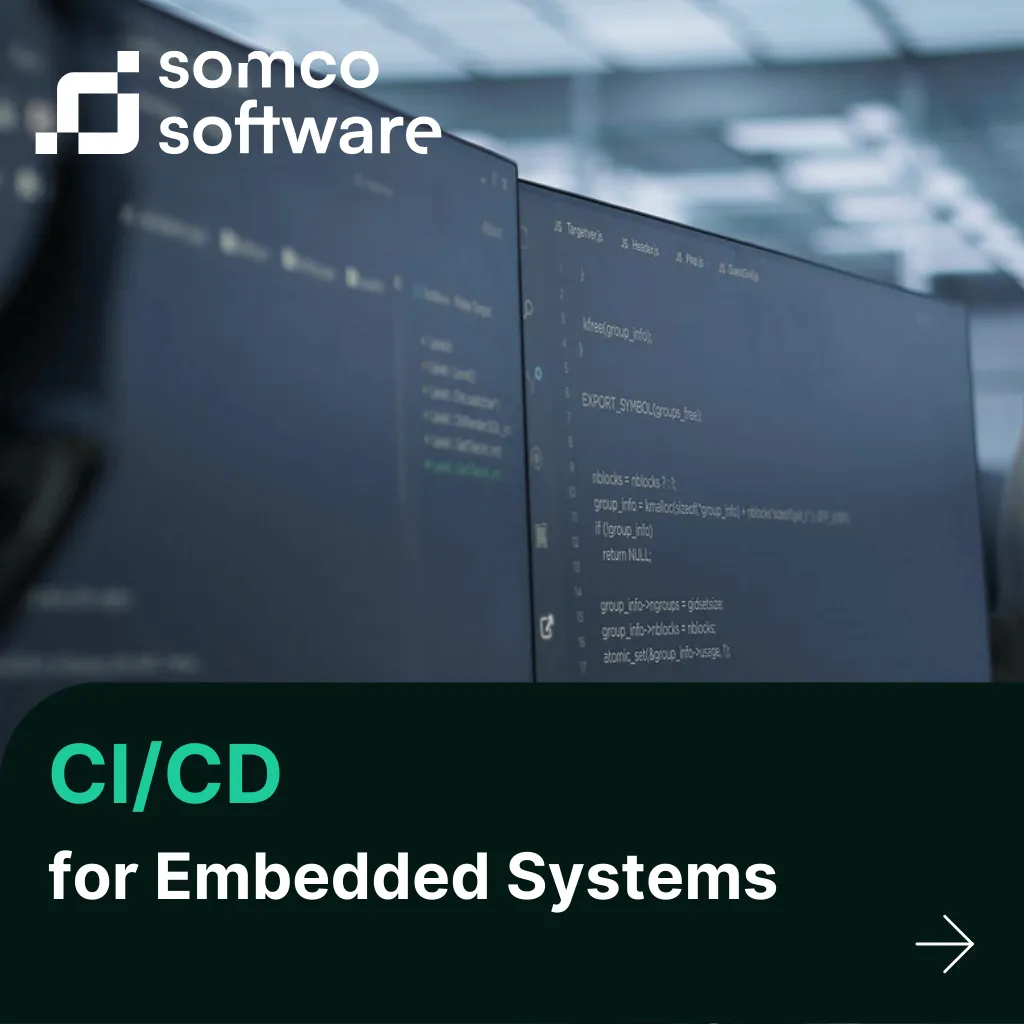
Embedded systems development has moved from manual, hardware-dependent workflows to automated processes that rival traditional embedded software development practices. As IoT devices proliferate and embedded systems get more complex CI/CD pipelines are a must have to stay competitive and deliver products to market faster.
While CI/CD principles are well established in traditional software development, applying them to embedded systems is different: hardware dependencies, cross compilation, real-time constraints, safety-critical considerations that require specialized approaches for embedded developers.
Knowing how to implement CI/CD for embedded systems and how to overcome the challenges is key for any organization developing connected devices, IoT products or embedded solutions.
This guide will help you:
Need help with your embedded systems development project?
Let’s talk about how our team can support your development goals and technical challenges.
CI/CD for embedded systems builds upon the same fundamental principles as traditional software CI/CD but adapts them to the embedded world. Continuous Integration means frequent integration of code changes from multiple developers into a shared repository, with automated builds and tests executed to catch integration issues early in the development process. Continuous Deployment/Delivery extends this concept by automating the packaging and deployment of validated software to target hardware platforms.
The embedded world introduces several critical considerations that are different from cloud or desktop application development, especially when it comes to continuous delivery. Hardware dependency is the biggest challenge, as embedded software is tightly coupled to specific hardware platforms and often requires cross compilation toolchains to generate executables for target architectures. Resource constraints are another limitation, as embedded devices have limited CPU, memory and storage compared to general purpose computers.
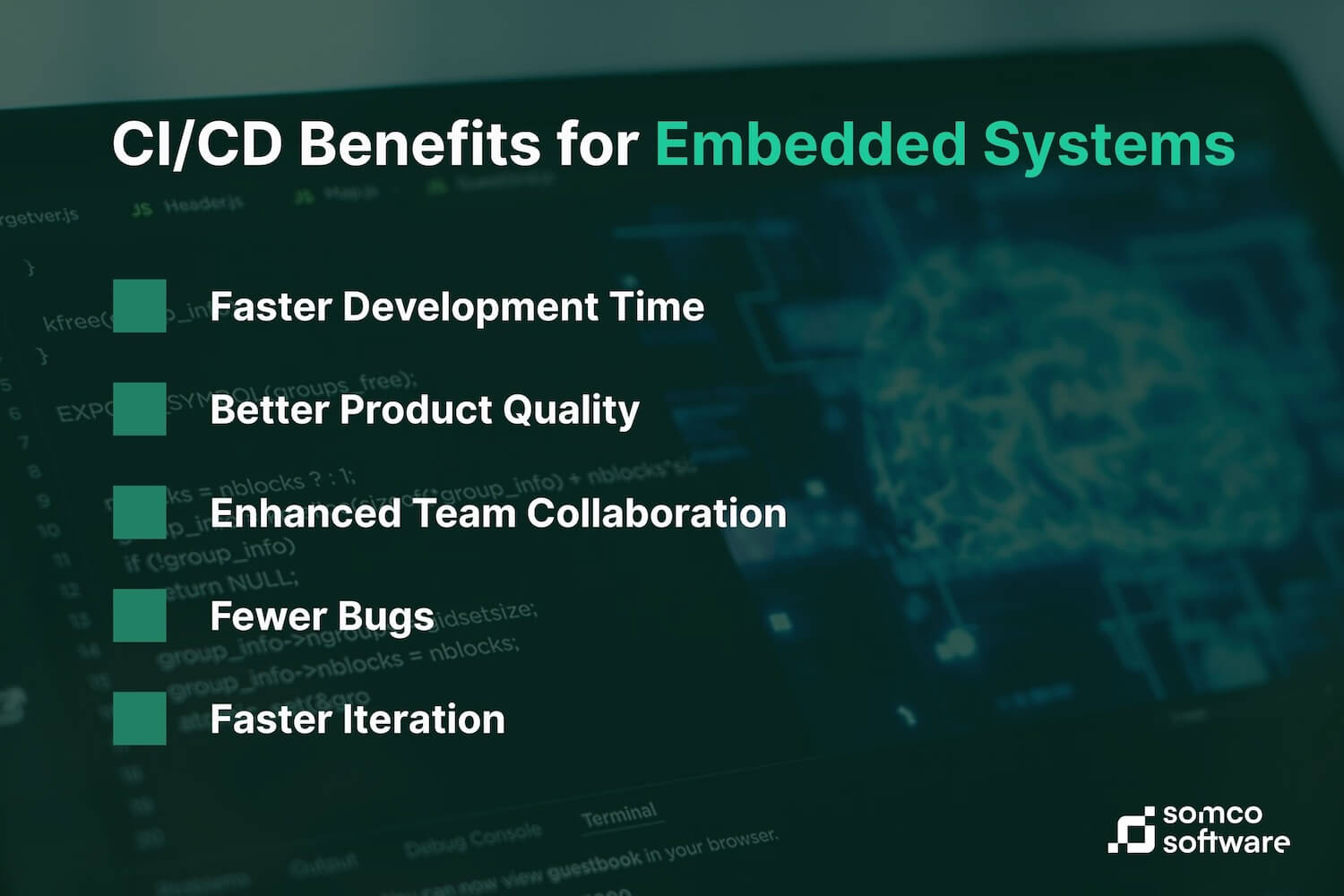
The implementation of CI/CD in embedded systems development brings many benefits that address traditional pain points in the field. Early error detection through automated testing prevents integration issues from propagating through the development cycle, reducing the cost and complexity of bug fixes, leading to better software quality. Improved collaboration results from standardized build environments and automated testing, enabling team members to work more effectively across different development platforms.
Faster development cycles emerge from automating manual processes, with some organizations reporting build time improvements of up to 2x through optimized CI/CD pipelines. Better product quality comes from consistent application of testing procedures and coding standards through automated analysis tools. Faster time-to-market becomes possible through faster iteration cycles and more reliable deployment processes.
One of the key aspects of implementing CI/CD for embedded systems is to have the same build environment across development teams, aligned with modern software development principles. Traditional embedded development often suffers from “works on my machine” syndrome, where software builds on one developer’s system but fails on another due to toolchain differences, library versions or environment configurations.
Containerization has become a great solution to this problem, with Docker being the de facto standard for packaging automated build system environments for embedded development. Using containers, development teams can package specific versions of cross-compilation toolchains, Software Development Kits (SDKs) and build dependencies into reproducible environments that can be shared across the entire team. This eliminates environment related build failures and reduces the time it takes for new team members to get up and running.
A typical containerized embedded development environment might include ARM GCC toolchains, CMake build systems, static analysis tools and testing frameworks, all locked to specific versions for reproducibility. Container orchestration platforms can further enhance this approach by allowing scalable CI/CD pipelines to handle multiple concurrent builds across different target architectures.
Modern embedded CI/CD pipelines must accommodate diverse hardware platforms and development platforms. This requires sophisticated build automation that can handle cross-compilation for multiple target processors while maintaining compatibility with various host development systems. Build tools such as CMake, Bazel, and specialized embedded build systems provide the foundation for creating portable build configurations that can execute consistently across different environments.
Caching is key to build performance for embedded systems where toolchains and dependencies can be large. Effective caching of ARM GCC toolchains, SDK components and intermediate build artifacts can reduce build times by avoiding repeated downloads and compilations. Modern CI/CD platforms have advanced caching mechanisms that can be configured to cache toolchain installations, dependency packages and even compiled object files.
HIL testing brings several benefits to embedded CI/CD pipelines. Full scenario coverage allows testing of thousands of operating conditions that would be impractical or dangerous to test on physical systems. Automated test execution enables continuous validation as part of CI/CD workflows, providing fast feedback on system changes. Early defect detection finds issues during development phases when they are cheaper to fix. Better security assessment through controlled testing of cybersecurity measures and vulnerability responses.
For methodology and tool details, read our article: Embedded Software Testing

Static code analysis is a must-have in embedded CI/CD pipelines, especially given the high quality and safety requirements of embedded applications and its place as one of the core components of the process. These tools analyze source code without executing it, identifying potential defects, security vulnerabilities and coding standard violations before software reaches target hardware.
Modern static analysis tools for embedded development cover C and C++ code, the most common programming languages in embedded systems. Commercial tools like Parasoft C/C++test have over 2,500 diagnostic rules for industry standards such as MISRA C/C++, CERT C/C++, AUTOSAR C++14 and various safety-critical coding guidelines. Open-source alternatives like Cppcheck have lower false-positive rates and are suitable for teams with budget constraints.
Static analysis is integrated into CI/CD pipelines during the build stage, after compilation and before automated testing. This allows early detection of code quality issues while maintaining fast feedback cycles essential to CI/CD workflows. Klocwork and other enterprise-grade tools have differential analysis capabilities, analyzing only changed code to minimize pipeline execution time while maintaining full coverage.
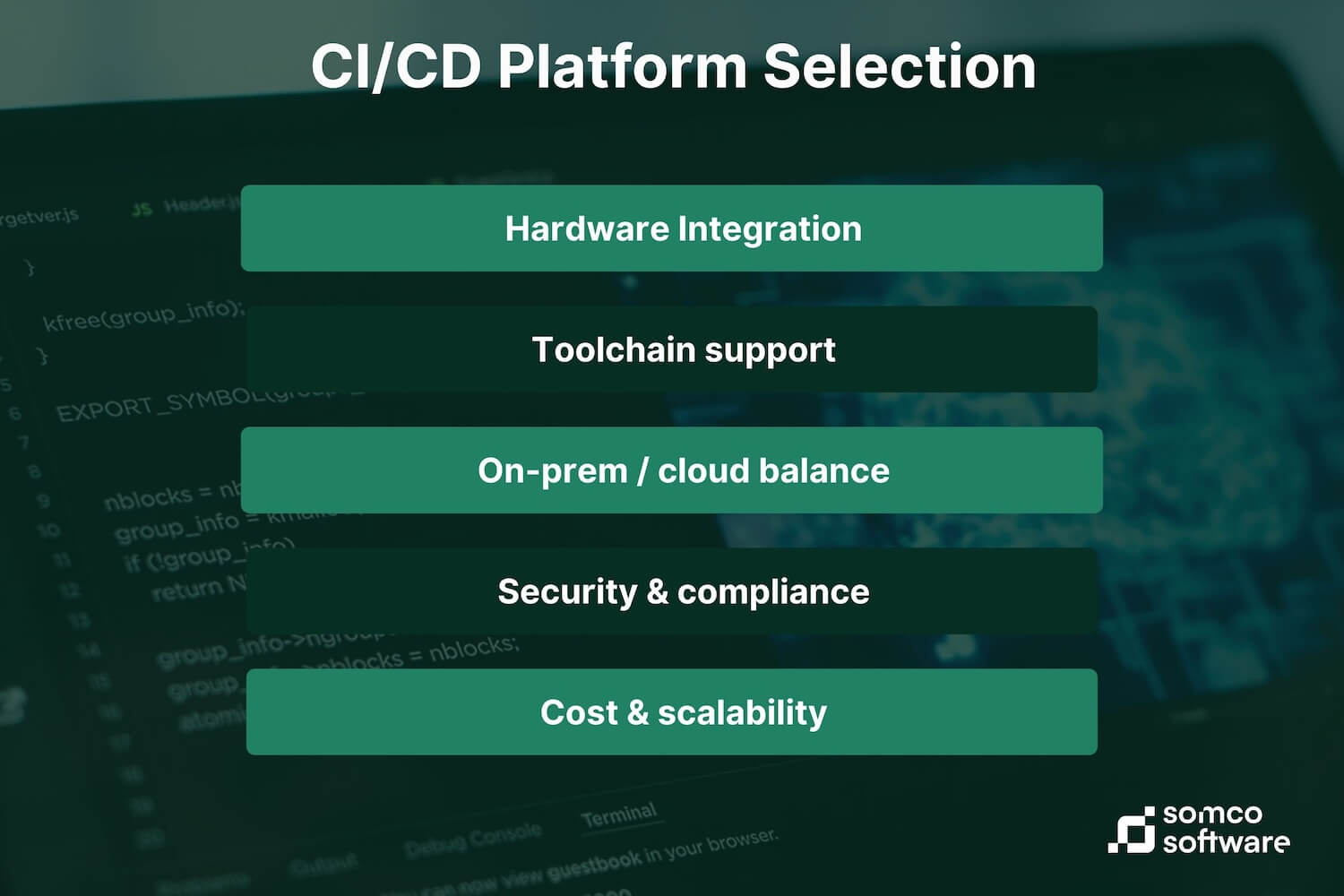
The choice of CI/CD platform has a big impact on embedded system development automation, especially when working with physical embedded devices. While general-purpose platforms like Jenkins, GitLab CI/CD, GitHub Actions and Azure DevOps provide a solid foundation, embedded development introduces specific requirements that influence platform choice.
GitLab CI/CD has become popular in embedded development due to its feature set and complex pipeline support. GitLab’s integrated approach combines source code management, CI/CD pipeline orchestration, container registry and security scanning in one platform. This simplifies workflow management and reduces tool chain integration complexity. GitLab’s large file storage (Git LFS) addresses the challenge of binary assets in embedded development and submodule support enables modular embedded software architecture.
Jenkins is still widely used in embedded environments due to its flexibility and plugin ecosystem. Jenkins’ ability to define physical build agents (slaves/runners) makes it suitable for embedded development workflows that require access to specific hardware platforms or toolchains. The scriptable pipeline configuration enables build orchestration that can handle the complexity of embedded software compilation, testing and deployment.
GitHub Actions provides cloud-native CI/CD with strong integration to the GitHub development platform. This makes it a great choice for embedded development teams that already use GitHub for source control and want a seamless developer experience. However, its cloud-centric nature may be a challenge for projects requiring on-premises execution or direct access to hardware targets.
Azure DevOps offers a comprehensive set of DevOps tools, including source control, pipelines, boards and artifact management. Its pipeline system is flexible and scalable, making it well-suited for enterprises with multiple teams and projects. As with GitHub Actions, Azure DevOps can face limitations in scenarios where specialized hardware access or fully on-premises execution is required.
When choosing a CI/CD platform for embedded consider hardware integration, toolchain support, scalability requirements, security and compliance features and cost. Organizations with multiple embedded projects benefit from platforms that provide project management and resource sharing capabilities.
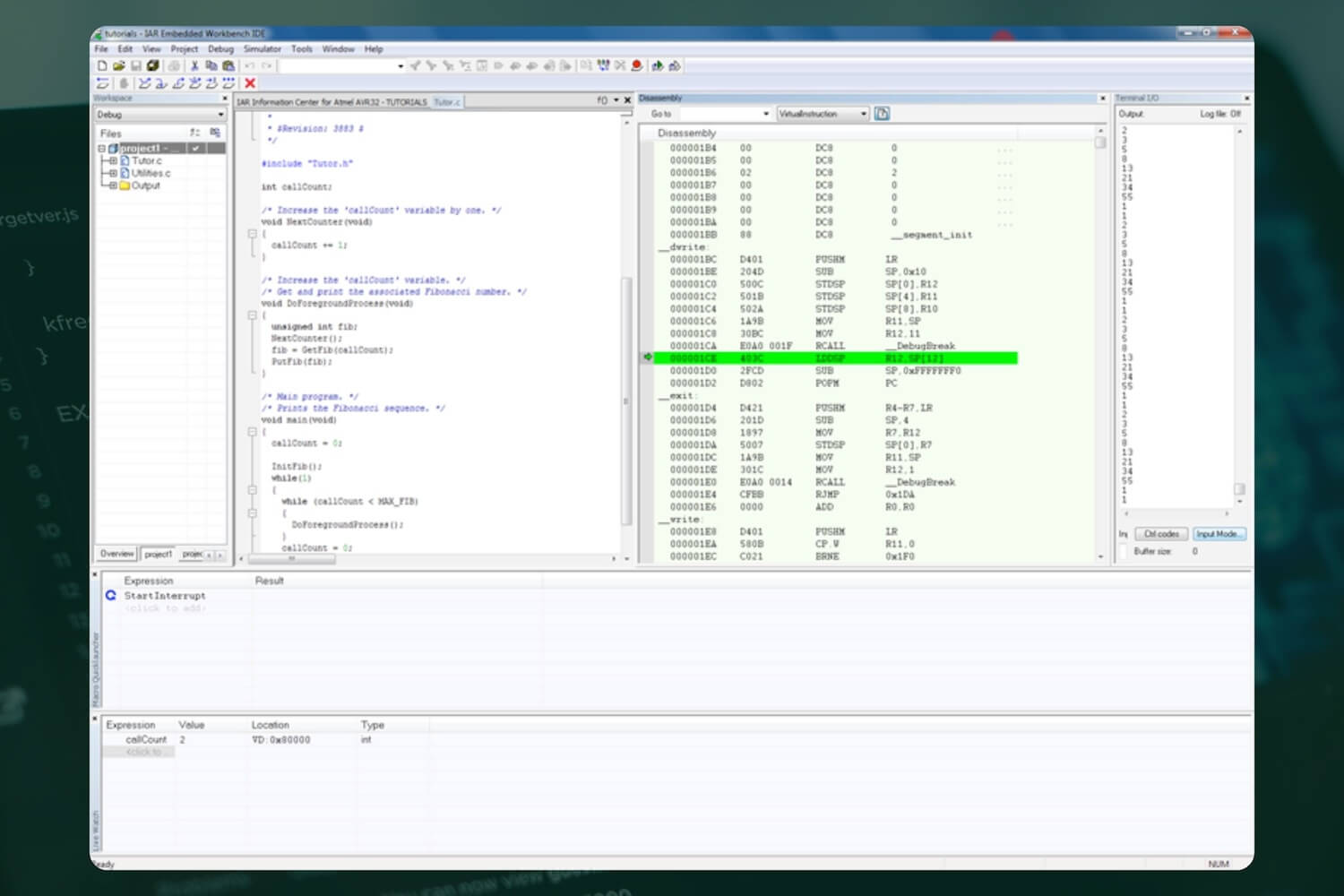
The embedded systems industry has seen the emergence of specialized CI/CD tools designed to address the unique challenges of embedded development. These tools often provide pre-configured support for embedded toolchains, static analysis and hardware testing that simplifies CI/CD implementation.
IAR Build Tools is an example of the trend towards embedded-specific CI/CD solutions. These tools provide command-line interfaces optimized for embedded development workflows, with reported 2x faster builds through multi-core processing optimization. The platform integrates with container orchestration systems and popular CI/CD platforms and provides pre-certified toolchains for functional safety applications.
IAR’s approach addresses several key embedded CI/CD requirements. Cross-platform compatibility ensures builds are the same across Ubuntu, Red Hat and Windows environments. Integrated static analysis through C-STAT is 3.5x faster on Linux platforms compared to traditional Windows-based workflows. Security scanning helps identify vulnerabilities early in the development process. Docker and virtual machine support simplifies deployment and scaling of CI/CD infrastructure.
Integration of specialized tools with broader CI/CD ecosystems is a key trend in embedded development. Organizations benefit from tools that provide embedded-specific optimizations while being compatible with industry-standard CI/CD platforms and practices.
As Cybersecurity for Embedded Systems becomes more important due to increased connectivity, organizations are adopting DevSecOps practices in embedded development, especially for code repository management. DevSecOps integrates security throughout the entire development lifecycle instead of security as an afterthought during final testing phases.
Shift Left Security is a fundamental principle of embedded DevSecOps, meaning security analysis and testing is integrated early in the development process. This provides multiple benefits including developer familiarity with security practices, continuous security validation throughout development cycles, better code quality and faster compliance certification. Early security integration also builds stakeholder trust by showing proactive security commitment.
Security automation in embedded CI/CD pipelines covers multiple dimensions, especially when deploying software in real-time environments. Static Application Security Testing (SAST) tools analyze source code for security vulnerabilities like buffer overflows, injection flaws and cryptographic weaknesses. Dynamic Application Security Testing (DAST) approaches are more challenging in embedded contexts but can validate security controls through simulation and hardware-in-the-loop testing. Dependency scanning ensures third-party libraries and components meet security requirements and are free from known vulnerabilities.
Modern embedded systems require Over-The-Air (OTA) update capabilities to address security vulnerabilities, deploy feature enhancements and fix operational issues without physical access to deployed devices, especially in line with version control systems for managing deployments. OTA update integration with CI/CD pipelines is a critical capability for maintaining embedded system security and functionality throughout device lifecycles.
OTA update systems use A/B partitioning schemes to increase update reliability by installing new firmware on inactive partitions. This allows for seamless switching between firmware versions via bootloader control and fail-safe rollback if updates fail. The bootloader plays a key role in OTA implementations, managing partition switching, update verification and system recovery.
CI/CD pipeline integration with OTA systems requires careful consideration of update package generation, cryptographic signing, version management and deployment orchestration. Automated CI/CD workflows can generate delta updates that minimize bandwidth by transmitting only changed components rather than complete firmware images, and thorough system testing during each update. Cryptographic signature verification ensures update authenticity and integrity, preventing unauthorized changes from being installed on target devices.
The deployment phase of OTA-enabled CI/CD pipelines often uses staged rollout strategies that deploy to a small device population first, monitor system performance and expand deployment scope based on success metrics. This minimizes the risk of widespread system failures while allowing for rapid deployment of critical security updates.
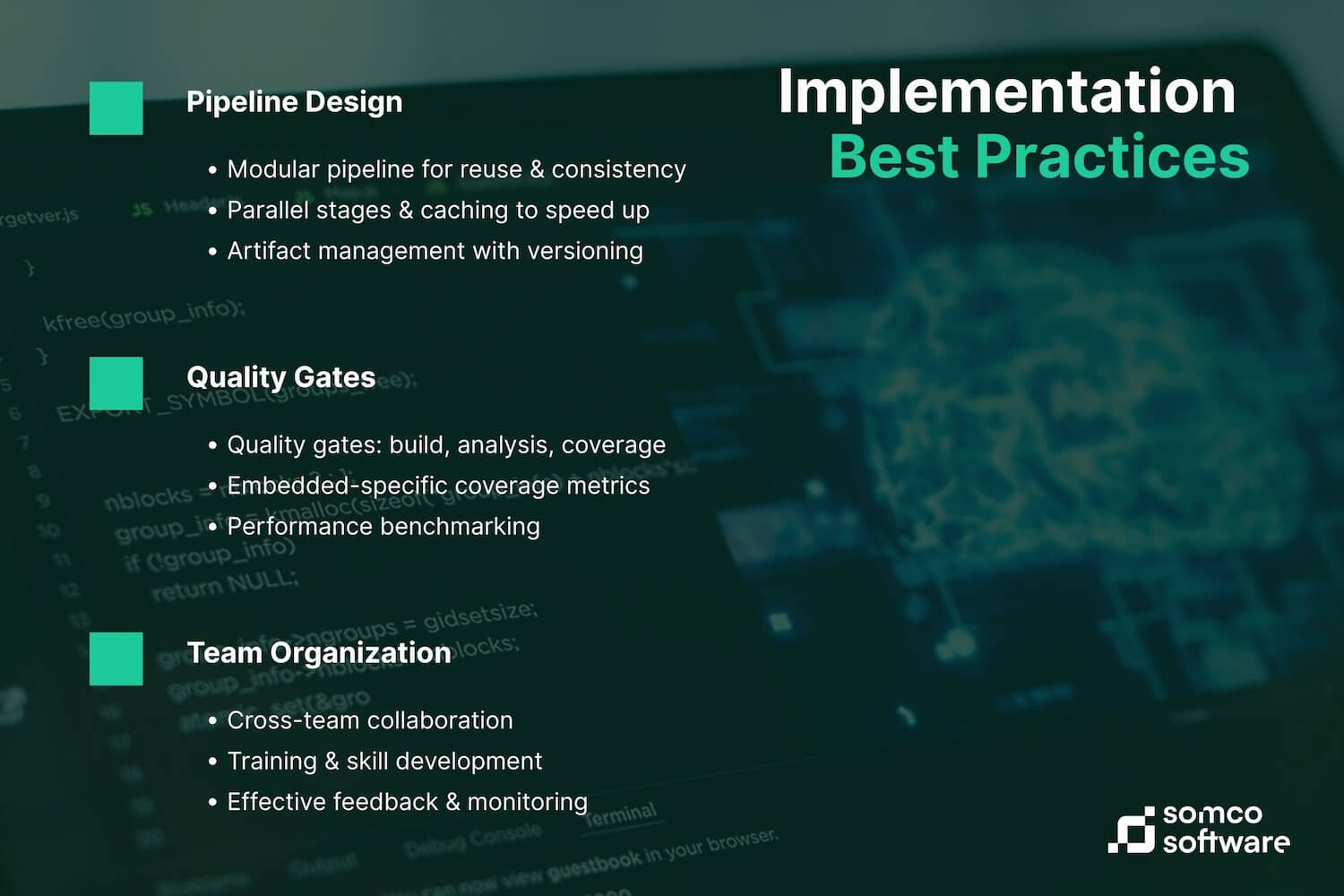
Embedded CI pipeline implementation requires consideration of pipeline design that takes into account the unique constraints and requirements of embedded development. Modular pipeline allows teams to create reusable components that can be applied across different projects and hardware platforms. This reduces maintenance overhead and ensures consistency of best practices across multiple development efforts.
Stage optimization focuses on minimizing pipeline execution time while maintaining full validation coverage. Effective embedded CI/CD pipelines use parallel execution where possible, such as running static analysis concurrently with compilation or running unit tests in parallel with integration test setup. Caching is particularly important in embedded pipelines due to the large size of cross-compilation toolchains and hardware simulation environments.
Artifact management requires consideration in embedded environments where build outputs may include not only executable binaries but also debug information, hardware configuration files and update packages. Effective pipelines use version-controlled artifact storage with appropriate retention policies that balance storage costs with debugging and traceability requirements.
Quality gates are checkpoints in CI/CD pipelines that prevent low quality code from progressing to later stages of the development process. In embedded development, quality gates typically include build success, static analysis threshold, unit test coverage and integration test.
Code coverage metrics provides quantitative measures of test effectiveness, but embedded systems require specialized approaches to coverage analysis that take into account hardware dependent code and interrupt service routines. Modern embedded development environments support various coverage types including statement coverage, branch coverage and modified condition/decision coverage (MC/DC) for safety-critical applications.
Performance benchmarking is another quality gate for embedded systems where real-time performance requirements must be validated continuously. Automated performance testing in CI/CD pipelines can detect performance regressions early, before issues are difficult to identify through functional testing alone.
Embedded CI/CD adoption requires organizational changes that go beyond technical implementation to encompass team workflows, communication practices and skill development within the embedded product development cycle. Cross-functional collaboration is key when development teams need to coordinate between hardware engineers, firmware developers and systems integration specialists.### Training and skill development
Training and skill development programs help team members adapt to automated development practices and understand how to use CI/CD tools and processes. This training should cover not only technical skills but also workflow practices such as commit frequency, branch management strategies and collaborative debugging techniques.
Feedback loops ensure that CI/CD pipeline results provide actionable information to enable rapid issue resolution. Effective implementations provide clear error reporting, debugging guidance and integration with development tools that developers use daily. Monitoring and alerting systems help teams respond quickly to pipeline failures and system issues.
CI/CD in embedded systems presents unique challenges that are different from traditional software development. These challenges stem from the dependency on physical hardware, resource constraints and complex integration requirements. The following table provides a summary of the main challenges faced by embedded development teams and the corresponding solutions.
| Challenge | Key Problems | Solutions | Limitations |
|---|---|---|---|
| Hardware-Software Dependencies | Software cannot be tested independently from hardware | Simulation, emulation, hardware abstraction | Simulation accuracy issues |
| Limited Hardware Availability | Pipeline bottlenecks, access conflicts | Hardware virtualization, abstraction strategies | Some tests require physical hardware |
| Scalability & Resource Management | Resource-intensive cross-compilation, simulations | Containerization, Kubernetes, cloud-hybrid | Performance overhead |
| Integration Complexity | Integration with existing infrastructure | IaC, pipeline templates, config management | Requires careful planning |
Embedded CI/CD is a fundamental change from manual to automated, scalable and reliable development processes, reducing development costs.
When starting with embedded CI/CD implementation, approach it systematically with clear objectives, right tools and full team training. Success is not just technical implementation but also organizational changes to support collaborative development and continuous improvement. With proper planning and execution, embedded CI/CD will deliver transformational improvements in development efficiency, product quality and organizational capability that will pay back the initial investment and set you up for long term success in a competitive and complex world.
Need help with your embedded project? – Contact our team to get started.
Let's face it? It is a challenge to get top Qt QML developers on board. Help yourself and start the collaboration with Somco Software - real experts in Qt C++ framework.
Discover our capabilities
As systems grow more complex and reliability becomes mission-critical, developers face an old but still unsolved dilemma: should you build […]
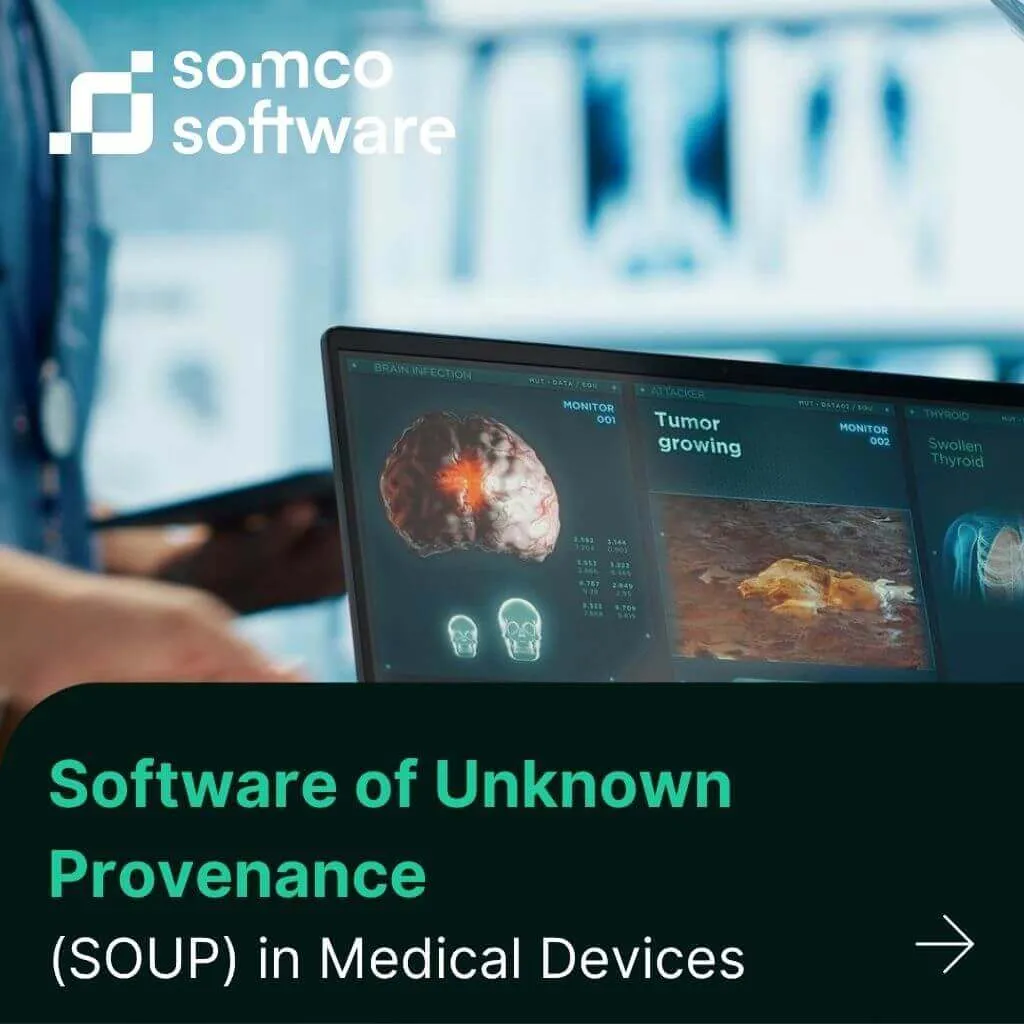
In the projects we deliver at Somco for medical device manufacturers, the topic of SOUP almost always comes up. Whether […]

As applications get more complex and performance expectations rise, multithreading becomes essential. In my experience, Qt provides a powerful — […]